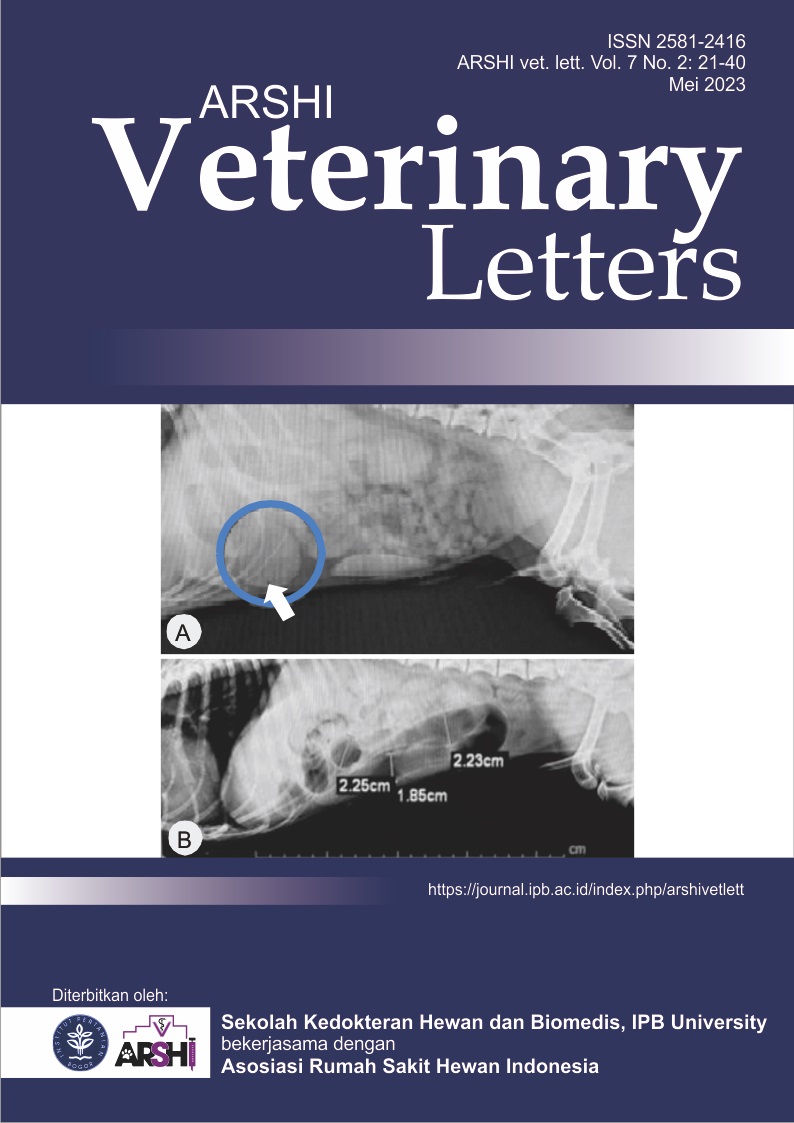Pemendekan waktu siklus estrus pada luwak Jawa (Paradoxurus hermaphroditus) terdeteksi melalui metode ulas vagina
Abstract
Luwak Jawa (Paradoxurus hermaphroditus) merupakan salah satu hewan liar yang dapat dimanfaatkan sebagai penyeleksi biji kopi untuk menghasilkan kopi berkualitas dan bernilai ekonomis tinggi. Pemeliharaan yang tidak sesuai dapat memengaruhi kondisi fisiologis dan reproduksi luwak sehingga penting untuk diketahui sebagai dasar manajemen pemeliharaan dan kesehatan untuk optimalisasi produksi, pencegahan penyakit, dan konservasi luwak. Pemantauan ini bertujuan untuk mengetahui panjang waktu total siklus estrus dan waktu dari setiap fase estrus yaitu fase proestrus, estrus, metestrus dan diestrus. Luwak Jawa dari diperoleh dari pasar hewan sebanyak 2 ekor berjenis kelamin betina dengan bobot badan sekitar 4 kg diambil data ulas vagina selama 21 hari pada pagi dan sore hari. Sel epitel vagina diperiksa di bawah mikroskop dan dianalisa secara kuantitatif. Hasil pengamatan menunjukkan pemendekan siklus estrus dengan panjang total siklus estrus yaitu 121,5±7,5 jam (5 hari). Durasi waktu proestrus 12,0±0,0 jam, estrus 22,5±3,0 jam, metestrus 25,5±3,0 jam dan diestrus 61,5±3,0 jam.
Downloads
References
Airin CM, Putro PP, Astuti P, Baliarti E. 2014. Level of estradiol 17-β serum and ovarian folliculare dynamics in short estrous cycle of bali cattle. Journal of the Indonesian Tropical Animal Agriculture. 39(1):23-29.
Bernstein LR, Mackenzie AC, Kraemer DC, Morley JE, Farr S, Chaffin CL, Merchenthaler I. 2014. Shortened estrous cycle length, increased FSH levels, FSH variance, oocyte spindle aberrations, and early declining fertility in aging senescence-accelerated mouse prone-8 (SAMP8) mice: concomitant characteristics of human midlife female reproductive aging. Endocrinology. 155(6):2287-2300.
Davidson AP, Baker TW. 2009. Reproductive ultrasound of the bitch and queen. Topics in companion animal medicine. 24(2):55-63.
Duckworth JW, Timmins RJ Choudhury A, Chutipong W, Willcox DHA, Mudappa D, Rahman H, Widmann P, Wilting A, Xu W. 2016. Paradoxurus hermaphroditus. The IUCN Red List of Threatened Species 2016: e.T41697A45218557
Gordts S, Puttemans P, Gordts S, Valkenburg M, Brosens I, Campo R. 2014. Transvaginal endoscopy and small ovarian endometriomas: unravelling the missing link?. Gynecological Surgery. 11:3-7.
Griffin B. 2001. Prolific cats: the estrous cycle. Compendium. 23(12):1049-1057.
Hien NT, Thao NT, Binh NT. 2018. A non-invasive technique to monitor reproductive hormone levels in common palm civets, Paradoxurus hermaphroditus Pallas, 1777. Academia Journal of Biology. 40(3):74-81.
Hinshelwood MM, Hansen PJ, Hauser ER. 1982. Short estrous cycles in postpartum cows as influenced by level of milk production, suckling, diet, season of calving and interval to first estrus. Theriogenology. 18(4):383-392.
Jöchle W, Andersen, AC. 1977. The estrous cycle in the dog: a review. Theriogenology. 7(3):113-140.
Mudappa D, Kumar A, Chellam, R. 2010. Diet and fruit choice of the brown palm civet Paradoxurus jerdoni, a viverrid endemic to the Western Ghats rainforest, India. Tropical Conservation Science. 3(3):282-300.
Nikolic O, Basta Nikolic M, Spasic A, Otero-Garcia MM, Stojanovic S. 2019. Systematic radiological approach to utero-ovarian pathologies. The British journal of radiology. 92(1099):20180439.
Patou ML, Debruyne R, Jennings AP, Zubaid A, Rovie-Ryan JJ, Veron G. 2008. Phylogenetic relationships of the Asian palm civets (Hemigalinae & Paradoxurinae, Viverridae, Carnivora). Molecular Phylogenetics and Evolution. 47(3):883-892.
Shi Z, Hu Z. 2008. A review of studies on animal reservoirs of the SARS coronavirus. Virus Research. 133(1):74-87.
Vaseem M, Raghuram V. 2017. Case report: Rabies in a small Indian civet Viverricula indica. International Journal. 6(1):330-333.
Copyright (c) 2023 CC-BY-SA

This work is licensed under a Creative Commons Attribution-ShareAlike 4.0 International License.
Authors who publish with this journal agree to the following terms:
1. Authors retain copyright and grant the journal right of first publication with the work simultaneously licensed under a Creative Commons Attribution License that allows others to share the work with an acknowledgement of the work's authorship and initial publication in this journal.
2. Authors are able to enter into separate, additional contractual arrangements for the non-exclusive distribution of the journal's published version of the work (e.g., post it to an institutional repository or publish it in a book), with an acknowledgement of its initial publication in this journal.
3. Authors are permitted and encouraged to post their work online (e.g., in institutional repositories or on their website) prior to and during the submission process, as it can lead to productive exchanges, as well as earlier and greater citation of published work (See The Effect of Open Access).


.jpg)















